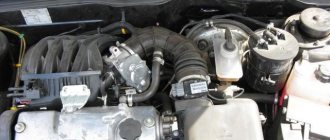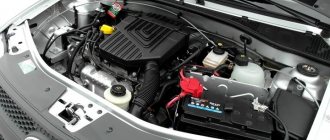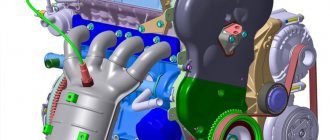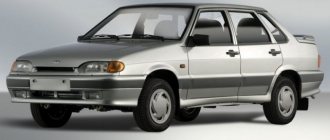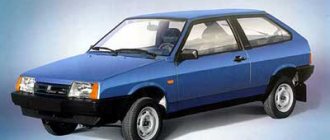Disconnect the wiring from the pump.
Using a Phillips screwdriver, remove the screws, and then remove the hatch cover located above the tank. The second ends of the orange wires are brought together to a point connected to plug “3” of the “X4” block of the mounting block. Their price is small, but their help and impact are significant. Wiring VAZ 2115. Part 2.
"Check engine" indicator lamp.
Table 7. For added safety, the model was supplemented with a brake signal and rear lighting. Thanks to different engines, the VAZ engine compartment wiring has its own design differences: the VAZ model has larger wiring harnesses due to the installation of additional sensors and electronic devices; The connectors of some electrical circuits have also changed; The layout of some of the wires has changed.
In addition, the layout of some of the electrical components as a whole was changed. On cars with an injection engine there is an additional unit located in the front passenger's feet.
When the lock socket illumination is on and the engine is running, the anti-theft locking device blocks the VAZ starter from re-engaging. The luggage compartment has become more spacious and convenient due to the increase in the trunk lid.
relays and fuses for the computer, Carlson and fuel pump
Description of the VAZ 2115 injector, all its pros and cons
The comfortable VAZ 2115 car is the founder of a popular family of domestic cars codenamed Samara-2. Attractive exterior design and extensive technical capabilities contributed to the growth of sales of the VAZ 2115 in the Russian domestic market. Without stopping at the achieved success, the manufacturer modernized the car several times, improving the functional and technical equipment of the VAZ 2115.
What is the VAZ 2115
The VAZ 21150 has an adjustable steering column, effective interior heating and an on-board driver warning system about closing the door locks, leaving the ignition key in the lock, the oil and coolant levels in the engine, and extreme wear of the brake pads. The spacious interior of the VAZ 2115 allows you to enjoy any trip.
The VAZ 2115 is equipped with gasoline engines with a displacement of 1.5 liters, both carburetor and with an electronic fuel injection control system with a five-speed manual gearbox. VAZ 21154 provides good handling and stability even on poor road surfaces.
VAZ-2115 became the first-born of the line codenamed “Samara-2”, after the Sputnik/Samara family, which became the most modified model of this family. This fact of modernization is confirmed by the fact that the VAZ-2115 has significantly changed the rear part of the car body. Namely the trunk lid, lighting devices. No similar transformations followed on the VAZ-2113 and VAZ-2114 cars. VAZ-2115 is a restyled model of VAZ-21099. The new model differs from its predecessor in the rounded shape of the hood and front fenders, trunk lid, new front and rear optics, bumpers painted in body color, trunk spoiler with an additional brake light, sill fairings, door moldings, as well as a new interior and upgraded electrical equipment.
What should the temperature be?
The temperature arrow tends to the red zone - soon overheating.
According to the international automobile convention of December 1, 1992, where 92 representatives of the auto industry gathered, it was decided to establish a single standard for engine temperature in operating condition.
This indicator is 90 degrees Celsius with a maximum permissible deviation of no more than 3 degrees Celsius.
With the development of the automotive industry and a sharp leap in technology in the 2000s, in 2004 it was decided to revise this indicator. So, having considered all the facts and analyzed the design features of many cars, it was decided to establish a floating indicator with marginally acceptable standards, which, today, is 85-105 degrees Celsius.
Exterior of the VAZ 2115 car
Initially, plans to modernize the Samara-2 line included changing not only the exterior of the body and trim, but also improving the suspension, transmission and braking system.
However, ultimately, all these nodes were borrowed from the Samara-1 family without any significant changes. This made it possible to achieve a high degree of unification with the “ninth” family. But the implemented improvements in appearance clearly benefited the car. The car received a more streamlined shape, thanks to which the angular outlines of the exterior, characteristic of the first generation Samar, are a thing of the past. Loading things into the trunk has become much more convenient - now the loading height is at the level of the bumper. And a more advanced injection engine develops more power, consumes less fuel and warms up faster.
In addition, the electronic engine management system monitors the level of exhaust toxicity.
Electrical equipment VAZ 2115
Electrical equipment has also been improved. Now the car's package includes: electric windows for the front doors, as well as fog lights and heated seats (only on “luxury” modifications). All versions are equipped with an on-board monitoring system that allows you to monitor the proper operation of lamps, oil level, brake pad wear, and the level of coolant and washer fluids, directly from the driver’s seat. At high speeds (namely 180-200 km/h) the road holds up well. The cross-country ability is very good for its class, the car is light and tall. Spare parts and repairs are relatively inexpensive. The trunk is very large, which is good.
car front panel
What's new and what remains from its predecessors
The VAZ 2115 has an adjustable steering column, effective interior heating and an on-board driver warning system about closing the door locks, leaving the ignition key in the lock, the level of oil and coolant in the engine, and extreme wear of the brake pads. The spacious interior of the VAZ 2115 allows you to enjoy any trip
If you compare the appearance of the VAZ 2115 and the VAZ 21099, you can immediately notice that the updated model differs in many respects. The design of the car has become more interesting; it fully complies with modern requirements and the main trends in the automotive industry. The car acquired a streamlined shape and smooth lines, the front and rear parts of the car have changed. The shape of the hood has become more convex, and the headlights and fenders of the car highlight the updated design. The roof and doors remained the same as the progenitor of this model - VAZ 21099. The rear and front bumpers were painted in body color. An additional “stop” signal has been created on the trunk spoiler in the VAZ 2115 model. The volume of the luggage compartment has become significantly larger due to a change in the shape of the trunk lid, which opens the opening all the way to the bumper.
In addition, new elements appeared: door moldings, the same color as the body, and fairings on the sills. Updates are also obvious in the lighting technology of the VAZ 2115 model, one of which is fog lights. Such changes will certainly be appreciated by even the most demanding motorists. The improvements carried out had a positive impact on the popularity of the VAZ 2115 model. The car fully complies with all the criteria and trends of modern automobile fashion. Experts note that the design update also contributed to improving the aerodynamic performance of the VAZ 2115.
VAZ 2115 interior design
The interior has become more comfortable compared to earlier models due to many improvements and new details: the dashboard has acquired a streamlined shape, and additional control sensors have appeared on it, signaling the driver about certain changes in the condition of the car.
Also in the VAZ 2115, the upper mounting points of the front seat belts have changed, and the mounting is height-adjustable, which is important for the safety of drivers and passengers of different heights and builds. A console appeared between the front seats, and the steering column became adjustable. In addition, the VAZ 2115 model is equipped with an improved interior heating system and an on-board control system. This system notifies the driver that the key is left in the ignition, that the engine is pumping coolant and lubricants, as well as the need to replace the brake pads, that the doors are closed, and that the seat belts are not fastened.
The VAZ 2115's spacious trunk and spacious interior made this model indispensable for travel and long-distance trips. The large rear seat, designed according to the laws of ergonomics, allows all passengers to experience convenience and comfort while driving.
Trouble the engine... Engine 16 model 21126
Oil is supplied to the main and connecting rod bearings, as well as to the camshaft supports under pressure; the cylinders, pistons, pins and rings, camshaft cams and pushers are lubricated by splashing; all other associated parts are lubricated by gravity. Removing the gas tank is carried out using a standard set of tools: wrenches of different sizes, a screwdriver and a hammer in case any element is difficult to dismantle.
| Volume | Transfers | Gasoline consumption by road type |
| Mixed | ||
| 1.5 | Mechanics | 7.8 |
| 1.5 | Mechanics | 7.6 |
| 1.6 | Mechanics | 7.6 |
Performance characteristics of the VAZ 2115 car
The exhaust emission level of this model strictly meets domestic requirements and European environmental standards EURO-3 (Euro III), and the car’s reliable power units will never let its owner down on the road.
The VAZ-2115 is equipped with a five-speed gearbox combined with a differential and final drive.
The five-speed gearbox is designed on the basis of the four-speed gearbox previously installed on cars of the Sputnik family.
The main difference between the five-speed gearbox is the additionally introduced fifth gear, the gears of which are installed in an enlarged rear cover.
PS While driving, the gearbox does not cause any difficulties, the gears are engaged smoothly (except for fifth), without jerking the car, but at high speeds (over 120 km/h) when switching from fourth to fifth gear, difficulties arise, this can lead to a shift in attention from the road on the lever and there is a danger of losing control (trust my experience)
The main power supply circuits of the electrical equipment of the VAZ 2115 car are protected from damage by fuses. Their price is small, but their help and impact are significant. After all, they protect more expensive equipment.
The exceptions are:
- battery charging circuit;
- ignition circuit;
- starter and generator power supply circuit.
Protection is realized using a fuse box assembled in the engine compartment. All powerful consumers, such as the starter, wipers and high beam lamps, are connected to the on-board network via a relay and are located in the mounting block.
The Pyatnashka is equipped with a starter type 5712.3708 - this is a DC electric motor with excitation from permanent magnets, with a planetary gearbox and an electromagnetic two-winding traction relay.
Four permanent magnets are fixed in the stator housing. The armature shaft rotates in two metal-ceramic liners installed in the cover and support. Rotation from the armature shaft is transmitted to the drive shaft through a planetary gearbox. Planetary gears rotate on needle bearings. The front end of the drive shaft rotates in a sintered bushing pressed into the clutch housing.
When the starter is turned on, the voltage from the battery through the ignition switch is supplied to both windings of the starter traction relay (retractor P1 and retainer P2). After closing the contacts of the traction relay, the retractor winding is turned off.
The Fifteenth model also has engines with a distributed fuel injection system, i.e. fuel is injected by four injectors (one injector per cylinder) into the intake pipe, onto the intake valves. Here the fuel evaporates, mixes with air and enters the engine cylinders in the form of a combustible mixture. The fuel injection system reduces exhaust emissions while improving the vehicle's driving characteristics.
Electrical wiring system maintenance
To ensure the functionality of the electrical system, it is necessary to regularly check and diagnose the components:
- If problems are detected in operation (even minimal malfunctions), the condition of the connecting plugs should be analyzed.
- Often, after the owner moves the pad, contact is restored. Further use of such elements is not recommended.
- The unit needs to be replaced with a similar one, while simultaneously finding out the cause of oxidation of the old parts.
Relay contacts are prone to burning when exposed to high current. The devices can be removed from the unit and the condition of the conductive contacts can be inspected.
This requires:
- Remove the plastic protective cover.
- Carefully clean the burnt contacts with fine sandpaper and blow with air.
If there is significant wear on parts, it is necessary to install new relays.
Due to the location of the installation box in the air supply channel, it becomes clogged with dust and is exposed to moisture. Over time, this leads to the destruction of the conductive paths on the printed circuit boards and loss of contact. The unit should be inspected once a year; if defects are found, it is recommended to replace it with a new one. At the same time, it is necessary to monitor the condition of the grounding wire, which can oxidize at the connection points.
For correct operation of consumers, it is necessary to check the condition of voltage sources. The battery should be periodically recharged from a stationary device. Charging the battery and the functioning of the electrical circuit while driving depends on the tension and condition of the generator rotor drive belt. When the commutator and brushes wear out, the operation of the generator is disrupted, which leads to the car losing power.
Two distributed injection systems: with and without feedback
The feedback system is used mainly on export vehicles. It has a neutralizer and an oxygen sensor installed in the intake system, which provides feedback. The sensor monitors the oxygen concentration in the exhaust gases, and the electronic control unit uses its signals to maintain an air/fuel ratio that ensures the most efficient operation of the converter. Only unleaded gasoline should be used as fuel. The use of leaded gasoline will damage the converter, oxygen sensor and system failure.
In an injection system without feedback, a converter and an oxygen sensor are not installed, and a CO potentiometer is used to adjust the CO concentration in the exhaust gases. This system also does not use a gasoline vapor recovery system. The figure shows the design of this particular system, since it will mainly be used on cars sold in Russia.
How to remove the fuel pump
Before this, you need to twist the negative terminal from the battery. Also, the gas tank must be completely empty.
To replace the pump, you will need to completely remove the fuel module. This, among other things, will allow you to clean the bottom of the tank from accumulated dirt. Before removing the module, it is necessary to reduce the pressure in the system. There is a fitting on the ramp for this.
Next you need to do the following:
- remove the protective cover to gain access to the module;
- disconnect the pump power terminal;
- unscrew the fuel hoses;
- loosen the lock of the module itself;
- remove it from the gas tank.
We should not forget that before performing the last action, you need to release the float. Replacing the entire unit is the simplest solution, since repairing its individual elements will require knowledge and extensive experience. If there is neither one nor the other, then it is better to contact a car service.
Description of the components of both systems and features of the system with feedback
The converter is installed in the exhaust system in front of the additional muffler. It contains two oxidation catalysts (chemical reaction accelerators) and one reduction catalyst. Oxidation catalysts (platinum and palladium) help convert hydrocarbons into water vapor and carbon monoxide into carbon dioxide. A reduction catalyst (radium) helps convert nitrogen oxides into harmless nitrogen. Because the catalytic converter requires oxygen to neutralize hydrocarbons and carbon monoxide, and at the same time it must take oxygen to neutralize nitrogen oxides, it is necessary to very carefully maintain the balance of the air/fuel mixture (approximately 14.7:1) entering the engine.
This function is performed by an electronic control unit. The electronic control unit (ECU), located under the instrument panel on the left side of the body, is the control center of the fuel injection system. This is a specialized computer. It continuously processes information from various sensors and controls systems that affect exhaust emissions and vehicle performance. The computer also performs a diagnostic function for the fuel injection system. It can recognize system malfunctions, warning the driver about them through the “CHECK ENGINE” indicator lamp. It also stores diagnostic codes that indicate areas of trouble to help technicians make repairs.
The air filter is installed in the front part of the engine compartment with rubber clips. Filter element 9 is paper, with a large filter surface area. When replacing the filter element, it must be installed so that the corrugations are located parallel to the center line of the car. Throttle pipe 19 is fixed to the receiver. It controls the amount of air entering the intake pipe.
The flow of air into the engine is controlled by a throttle valve connected to the accelerator pedal drive. The throttle pipe includes a throttle position sensor 23 and an idle speed regulator 24. In the flow part of the throttle pipe (in front of the throttle valve and behind it) there are vacuum sampling holes necessary for the operation of the gasoline vapor recovery system. If the latter system is not used, then the fitting for purging the adsorber is plugged with a rubber plug.
The idle speed regulator 24 regulates the crankshaft speed at idle by controlling the amount of air supplied bypassing the closed throttle valve. It consists of a two-pole stepper motor and a cone valve connected to it. The valve extends or retracts according to signals from the ECU.
The throttle position sensor 23 is installed on the throttle pipe body 1 and is connected to the throttle valve axis. The sensor is a potentiometer, one end of which is supplied with a 5 V supply voltage, and the other end is connected to ground. From the third terminal of the potentiometer (from the slider) the output signal goes to the ECU.
Didn't find the information you are looking for? on our forum.
Removing, installing and replacing the fuel pump
The first thing to keep in mind is that all work on the car’s fuel system must be carried out with the negative terminal of the battery disconnected. It would also be a good idea to do this with an empty fuel tank, especially since with the fuel module removed it becomes possible to clean the bottom of the gas tank from sediment.
The second thing it is advisable to do is to remove the pressure inside the fuel lines so as not to get a stream of gasoline in your face or into the interior of the car. This can be done using a measuring nipple on the fuel rail and a thin screwdriver.
To work you should prepare:
- curved and flat screwdrivers
- key for 17
- head for 7
- rags
Sequence of work
- Raise the rear sofa.
- We unscrew the two screws that hold the cover that blocks access to the fuel module, and disconnect the electrical connector from it.
- Using a 17mm wrench, unscrew the two fuel lines connected to the pump, being careful not to lose the O-rings, and move them to the sides.
- Newer models have clips on the pump; to remove them, press them and pull the tubes towards you.
- Using a 10mm socket, unscrew the 8 nuts that secure the pressure plate in a circle, holding the entire fuel module.
- Carefully remove it through the hole in the gas tank, having first released the fuel level sensor float.
If there is a new assembled module in stock, install it in the reverse order. If it is necessary to replace individual components: the fuel pump itself, the level sensor or the primary filter mesh, we do this by disassembling the fuel module housing and removing the corresponding parts.
This procedure is unlikely to cause any difficulties - everything is quite obvious.
For a new type of fuel pump, you need a 10mm socket and a ratchet, similarly unscrew the ring in a circle and press out the fuel line clamps.


